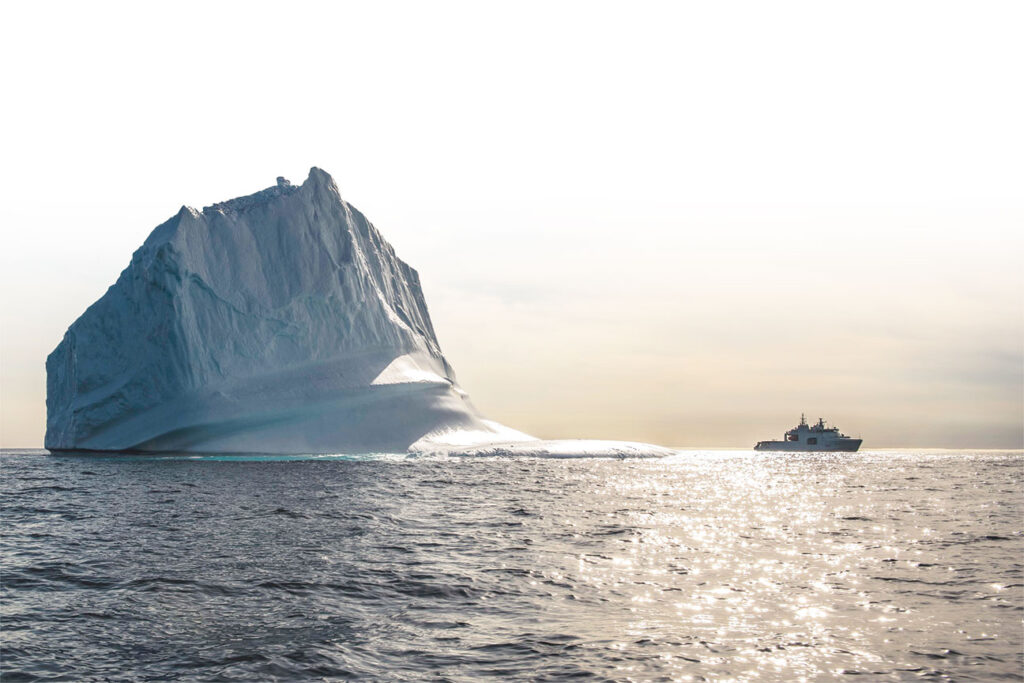His Majesty’s Canadian Ship Harry DeWolf encounters a 25-story iceberg in the Southern Davis Strait, Nunavut. PVT. BRENDAN GAMACHE/CANADIAN ARMED FORCES
Jutting northward from the continent of North America, the iconic shape of Canada’s Arctic Archipelago not only makes Canada’s Arctic unmistakable on a world map, but it also makes this region unique in the world. The rapidly changing Arctic is increasingly becoming an arena of both opportunity and risk. Shrinking sea ice, emerging sea lanes and interest in natural resources have amplified the strategic importance of the North, drawing the attention of Arctic and non-Arctic nations alike. Our North, Strong and Free: A Renewed Vision for Canada’s Defence (ONSAF), the update to Canada’s defense policy published in 2024, makes it clear that safeguarding the Arctic is a primary focus for the Canadian Armed Forces (CAF) and that Canada’s domestic and foreign policy is predicated on a secure Arctic.
Canada’s Arctic lands, islands and waters are vast, remote and sparsely populated. They possess a harsh climate and limited infrastructure. Operating in and defending Canada’s Arctic presents unique challenges for the CAF that require innovative solutions. Canada’s internal and external partnerships are a key component in meeting these security objectives.
Effective deterrence requires both capacity and persuasion. The side enforcing deterrence must have a capacity to respond to threats by imposing a cost on an aggressor. The capacity for imposing such costs should be demonstrable, repeatable and deliberately controlled by the deterring party. Equally important is the ability of that deterring party to convince any potential aggressor that a strong and swift response will be taken against any aggression. The security situation in the region has become increasingly critical, rivaling other regional hot spots of strategic importance. Credible deterrence in the Arctic is a persistent and growing need due to the following factors:
- The Arctic is an important approach to North America. While Canada has in the past collaborated with the United States on continental defense primarily through the North American Aerospace Defense Command, threats through the Arctic no longer are limited solely to the aerospace domain.
- The danger of conflict in other regions spilling over into the Arctic is a growing concern.
- Natural resources in the Arctic must be safeguarded against exploitation by foreign competitors.
- Reinforcing deterrence therefore requires a balance of two processes, both of which must be supported by effective communication.
- Improving capabilities, including platforms, infrastructure, equipment, sensors and personnel.
- Taking action to practice and demonstrate existing capabilities, improve techniques and foster interoperability.
Enduring partnerships between Canada, the U.S. and other allies support both capabilities and actions. While much public attention is paid to the acquisition of capabilities, the effective and collaborative employment of those capabilities makes an outsized impact on operational effectiveness. Through these enduring partnerships, we reduce and eliminate potential seams and divisions in our collective defense.
As such, Operation Nanook is Canada’s premier Arctic defense and security operation. It comprises several annual activities across Canada’s North. One of those activities is Operation Nanook-Nunalivut (Op NA-NU). “Nanook” means “polar bear” and “Nunalivut” means “land that is ours” in Inuktut. Op NA-NU, which takes place in February and March in various locations, demonstrates, develops and conducts research related to deploying, operating and fighting in Arctic winter conditions. In line with ONSAF, the CAF are expanding the scope of Op NA-NU from 2025 onward to include more participation from across the CAF and from allied nations. Some examples of this increased international participation include the 109th Airlift Wing, the Montana Air National Guard, U.S. Navy Explosive Ordnance Disposal and several researchers from the International Cooperative Engagement Program for Polar Research.
Canada is also looking to expand several of its other Operation Nanook activities and add new ones to strengthen its year-round presence and adopt a pan-domain approach to Arctic security. As warming waters continue to reshape the Arctic, Canada’s commitment to a secure and stable North has never been more critical. Safeguarding sovereignty and security in this vast, challenging region requires a multifaceted approach that leverages national will, resources and the strengthening of enduring partnerships. Canada’s integration of internal partnerships, including collaboration with local communities, alongside robust alliances with the U.S. and like-minded nations, demonstrates a comprehensive strategy to maintain Arctic security.
In the face of emerging threats and a rapidly changing environment, Canada’s approach — built on internal resilience and international cooperation — ensures the Arctic remains a secure, prosperous region for generations to come. This ongoing focus on partnerships, reinforced by credible deterrence and operational readiness, will be essential as Canada continues to fulfill its responsibility to protect this vital and unique part of the world.

